|
|
|
Sort Order |
|
|
|
Items / Page
|
|
|
|
|
|
|
| Srl | Item |
| 1 |
ID:
138591
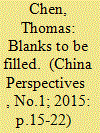

|
|
|
|
|
| Summary/Abstract |
Jia Pingwa’s Decadent Capital was wildly popular upon its publication in 1993. Offering plenty of sex and a bleak view of Chinese society under reform, it was also highly controversial, not least because of the blank squares strewn throughout the text to represent erotic descriptions edited out by the author. Commentators accused Jia of selling out high culture, much like the intellectuals portrayed in the narrative. The novel was banned in 1994 but rereleased in 2009 with one major change: the blank squares were replaced by ellipses. I argue that these blank squares not only make public censorship itself but also constitute the space of alternative publics, whether harking back to an elided past or projecting into a future yet to be written, that the post-Tiananmen Party-state tries to nullify. KEYWORDS: Jia Pingwa, censorship, publishing industry, postsocialism, dystopia, utopia, Tiananmen Square, public, criticism, Lu Xun.
|
|
|
|
|
|
|
|
|
|
|
|
|
|
|
|
| 2 |
ID:
137529
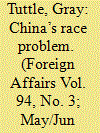

|
|
|
|
|
| Summary/Abstract |
For all the tremendous change China has experienced in recent decades—phenomenal economic growth, improved living standards, and an ascent to great-power status—the country has made little progress when it comes to the treatment of its ethnic minorities, most of whom live in China’s sparsely populated frontier regions. This is by no means a new problem. Indeed, one of those regions, Tibet, represents one of the “three Ts”—taboo topics that the Chinese government has long forbidden its citizens to discuss openly. (The other two are Taiwan and the Tiananmen Square uprising of 1989.)
|
|
|
|
|
|
|
|
|
|
|
|
|
|
|
|
| 3 |
ID:
146470
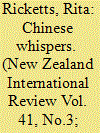

|
|
|
| 4 |
ID:
004946
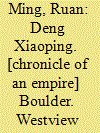

|
|
|
|
|
| Publication |
Boulder, Westview Press, 1994.
|
| Description |
xxi, 288p.pbk
|
| Standard Number |
081331920X
|
|
|
|
|
|
|
|
|
|
|
|
Copies: C:1/I:0,R:0,Q:0
Circulation
| Accession# | Call# | Current Location | Status | Policy | Location |
| 036017 | 951/MIN 036017 | Main | On Shelf | General | |
|
|
|
|
| 5 |
ID:
106724
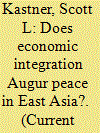

|
|
|
|
|
| Publication |
2011.
|
| Summary/Abstract |
At the end of the day, it is not clear that economic ties will act as a significant constraint on state behavior when high-stakes issues are on the table.
|
|
|
|
|
|
|
|
|
|
|
|
|
|
|
|
| 6 |
ID:
124160


|
|
|
|
|
| Publication |
2013.
|
| Summary/Abstract |
This article addresses the problem of generational transmission of collective memory in Hong Kong about the 1989 Tiananmen Square incident. It focuses on the young participants in the annual 4 June commemoration rallies and examines the process of mnemonic socialization that brought them into the community of 4 June commemoration. Drawing upon a rally onsite survey and in-depth interviews, this study found that many young people went through a dynamic process of gradual discovery in which various social institutions-school, family and media-played complementary roles. Their understanding of Tiananmen tended to be simplified and essentialized. Yet the loss of details through essentialization has arguably allowed them to uphold a clear-cut moral judgment regarding the event and dismiss certain memory-blurring discourses straightforwardly.
|
|
|
|
|
|
|
|
|
|
|
|
|
|
|
|
| 7 |
ID:
128511
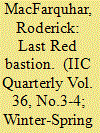

|
|
|
| 8 |
ID:
144174
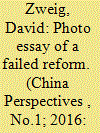

|
|
|
|
|
| Summary/Abstract |
In mid-1975, Deng Xiaoping, with Mao’s blessing, initiated reforms that targeted the negative consequences of the Cultural Revolution. To bolster Deng’s effort, Mao endowed him with penultimate authority over the Party, government, and military. However, in late October, Mao turned on Deng, and within five months, Mao and the radicals toppled Deng from power. As a foreign student at Peking University, David Zweig observed and photographed four key points in this historic struggle: (1) the initial establishment of a “big character poster” compound at Peking University; (2) emotional mourning for Zhou Enlai in Tiananmen Square following his death: (3) the intensified assault on Deng in February 1976 in the posters at Peking University; and (4) the massive demonstration of support in Tiananmen Square on 3-4 April for the end of Maoist politics.
|
|
|
|
|
|
|
|
|
|
|
|
|
|
|
|
| 9 |
ID:
119901
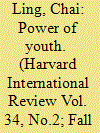

|
|
|
|
|
| Publication |
2012.
|
| Summary/Abstract |
On June 4, 1989, I fled through the streets of Beijing as government officials crushed the student movement we had so passionately held in Tiananmen Square. It was soon reported that our earnest attempt to have peaceful dialogue with our nation's leaders had been a total failure, though some still say otherwise. For 10 months, I hid underground in China, running for my life from those who should have protected us.
|
|
|
|
|
|
|
|
|
|
|
|
|
|
|
|
| 10 |
ID:
095517
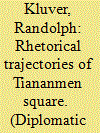

|
|
|
|
|
| Publication |
2010.
|
| Summary/Abstract |
In April and May of 1989, the protest movement that began in Tiananmen Square, in the center of Beijing, became one of the most dramatic and defining episodes in the presidential administration of George H. W. Bush. Global media covered the events daily, feeding images around the globe of students engaged in a standoff with police and military units. While the movement began as mourning for the death of the reformer Hu Yaobang, the drama quickly took on a different character, as students turned their attention from Hu Yaobang and towards perceived failures of the Communist Party of China (CPC) and corruption. The movement ultimately culminated in the bloody military crackdown against the protesters on the night of June 3-4, 1989.
|
|
|
|
|
|
|
|
|
|
|
|
|
|
|
|
| 11 |
ID:
149565
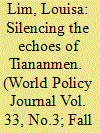

|
|
|
|
|
| Summary/Abstract |
Journalist Louisa Lim describes how the Chinese Communist Party has compelled China to forget the bloody crackdown around Tiananmen Square in 1989. To create this national amnesia, the government repressed political ambitions and funneled aspirations toward the economic sphere—a worrying fact for the Communist Party as the country’s GDP growth slows.
|
|
|
|
|
|
|
|
|
|
|
|
|
|
|
|
| 12 |
ID:
182368
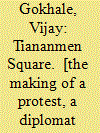

|
|
|
|
|
| Publication |
Noida, HarperCollins Publishers, 2021.
|
| Description |
xv, 183p.pbk
|
| Standard Number |
9789354225352
|
|
|
|
|
|
|
|
|
|
|
|
Copies: C:1/I:0,R:0,Q:0
Circulation
| Accession# | Call# | Current Location | Status | Policy | Location |
| 060106 | 951.05/GOK 060106 | Main | On Shelf | General | |
|
|
|
|
| 13 |
ID:
131645
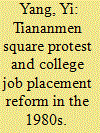

|
|
|
|
|
| Publication |
2014.
|
| Summary/Abstract |
The Tiananmen Square massacre left a permanent scar on the Chinese government's legitimacy to govern. This article examines a little-known backdrop to the student movement: the college graduate job placement system reform and the civil service recruitment system reform that were rolled out together by the state in the mid to late 1980s. The two reforms were interlocking, because civil service jobs were the most desired jobs for graduates at the time. As the college job placement system reform placed a greater burden on the individual student to find a job for him or herself, the civil service recruitment system reform remained opaque. This led to strong student disaffection as graduates tended to believe that the forthcoming open job market was to be filled with more nepotism and less meritocracy and this perceived lack of fair recruitment opportunities extended to the greatly desired civil service jobs.
|
|
|
|
|
|
|
|
|
|
|
|
|
|
|
|
|
|
|
|
|